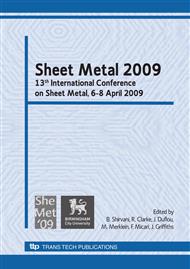p.69
p.79
p.87
p.97
p.105
p.117
p.127
p.143
p.151
Advanced Joining Technologies for Aluminium Assembly for the Automotive Industry
Abstract:
The increased application of lightweight materials, such as aluminium has triggered many investigations into new joining techniques for aluminium alloys. The Resistance Spot Welding concept for aluminium has always attracted many researchers from different organizations. Self-piercing riveting is the major production process used to join aluminium sheet body structures for the automotive industry. Mean while, interest in laser welding and application as a candidate for joining aluminium is also growing. These key technologies for aluminium assembly are therefore being investigated by the research team at the University Of Warwick. The paper reported here looks at the feasibility of each process for joining thin gauge aluminium and compares the mechanical behavior for each joint type. The results suggested that all three joining technologies are feasible for joining aluminum and their mechanical behaviour is strongly dependent on the selection of process parameters
Info:
Periodical:
Pages:
105-116
Citation:
Online since:
March 2009
Authors:
Price:
Сopyright:
© 2009 Trans Tech Publications Ltd. All Rights Reserved
Share:
Citation:


